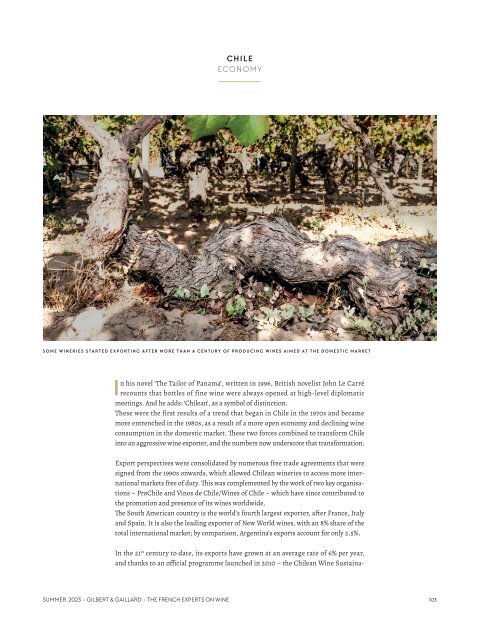You also want an ePaper? Increase the reach of your titles
YUMPU automatically turns print PDFs into web optimized ePapers that Google loves.
CHILE<br />
ECONOMY<br />
SOME WINERIES STARTED EXPORTING AFTER MORE THAN A CENTURY OF PRODUCING WINES AIMED AT THE DOMESTIC MARKET<br />
In his novel ‘The Tailor of Panama’, written in 1996, British novelist John Le Carré<br />
recounts that bottles of fine wine were always opened at high-level diplomatic<br />
meetings. And he adds: ‘Chilean’, as a symbol of distinction.<br />
These were the first results of a trend that began in Chile in the 1970s and became<br />
more entrenched in the 1980s, as a result of a more open economy and declining wine<br />
consumption in the domestic market. These two forces combined to transform Chile<br />
into an aggressive wine exporter, and the numbers now underscore that transformation.<br />
Export perspectives were consolidated by numerous free trade agreements that were<br />
signed from the 1990s onwards, which allowed Chilean wineries to access more international<br />
markets free of duty. This was complemented by the work of two key organisations<br />
– ProChile and Vinos de Chile/Wines of Chile – which have since contributed to<br />
the promotion and presence of its wines worldwide.<br />
The South American country is the world’s fourth largest exporter, after France, Italy<br />
and Spain. It is also the leading exporter of New World wines, with an 8% share of the<br />
total international market; by comparison, Argentina’s exports account for only 2.5%.<br />
In the 21 st century to date, its exports have grown at an average rate of 6% per year,<br />
and thanks to an official programme launched in 2010 – the Chilean Wine Sustaina-<br />
SUMMER 2023 • GILBERT & GAILLARD - THE FRENCH EXPERTS ON WINE<br />
103

















